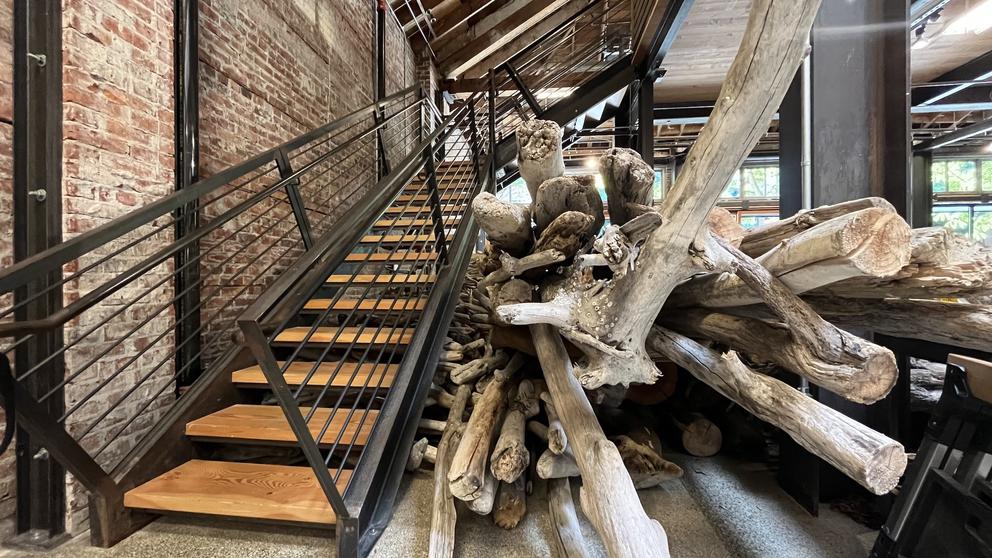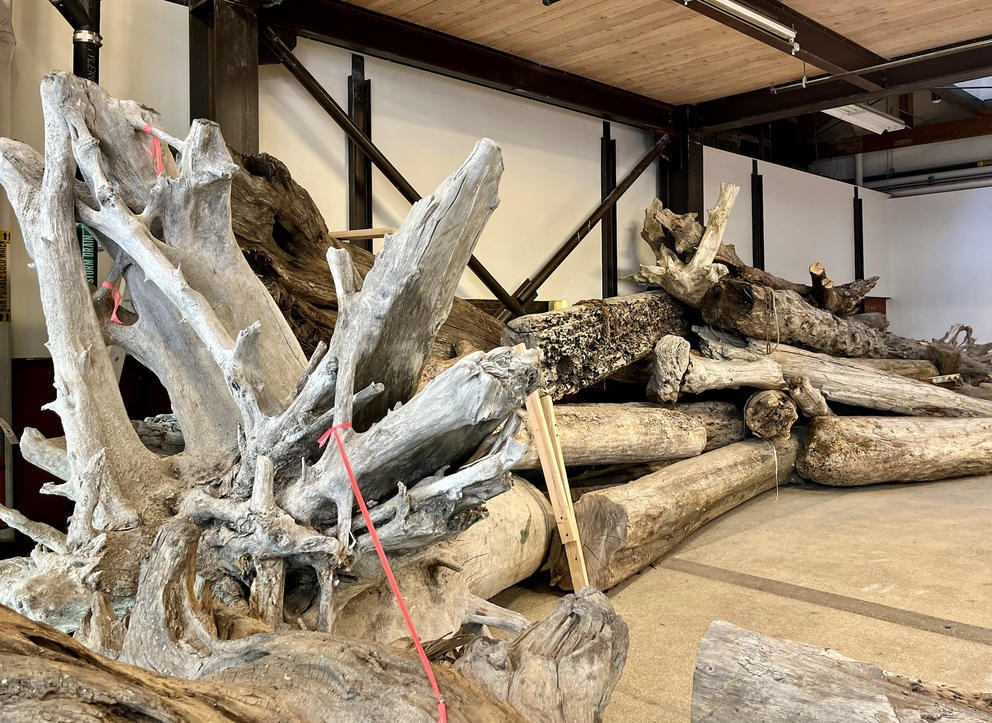One bleached stump splays its roots like a gargantuan sea anemone. Other logs are pocked with holes, pierced with metal bits, adorned with rusty chains and in one case, scraped with a swath of green paint from a boat collision. On another, a tuft of yellowed grass bursts forth like a firework.
ArtSEA: Notes on Northwest Culture is Crosscut’s weekly arts & culture newsletter.
Standing amid the timbers that crowd the gallery, you can smell sun-dried cedar laced with creosote — a hint that some of these logs have been subject to human industry. Weighing up to 2,500 pounds and stretching 22 feet long, the driftwood pieces are currently being pushed, dragged, lifted and secured into a towering wave form that when finished (open studio through Sept. 30; exhibit runs Oct. 2 – Nov. 23) will cradle visitors in a contemplative, aromatic space.
I first encountered Stigora’s work at the Blackfoot Pathways forested sculpture park, outside Missoula, Montana (highly recommended if you’re ever in the area). Her stunning piece “Clearing” is a human-scale nest made from wood charred by wildfires. Sitting inside it is a meditative experience, enveloped in both the dead wood of the sculpture and the living trees all around. Stigora told me she hopes the new piece will offer a similar opportunity for reflection — perhaps especially necessary in the current moment.
“We need places for decompression right now,” she says. “We need to slow down.”
Originally from Philadelphia, Stigora has been creating large reclaimed-wood installations for more than a decade. (If you missed her previous local installation, at Method Gallery, you aren’t alone — it opened the first weekend of March, 2020. Oof.) She told me that when she first visited Seattle in 2013, she was astounded by the driftwood she saw washed up on coastlines, and the forts that locals build from it. “The art that I want to make already exists here on the beaches,” she recalled thinking. “People from here are just accustomed to it,” she marveled. “But for me, it was like walking into Where the Wild Things Are.” In 2015, she moved here.
Looking at the amassed driftwood, Stigora told me she has been thinking about the timeline of these trees, and their journey through the watershed. “These all started as seeds,” she noted. Over decades, they grew huge. Some fell over naturally, some were cut and chained for various human needs, some had second lives as docks or log booms. They all ended up rolling around in Puget Sound for untold days, and now will have another existence as art. And after the show is over, most of the wood will be used for restoration of beach habitats around Puget Sound.
Another component of “Salvage” still in progress is an ambient audio track (by Rachael Fasano) that will pair the low rumbling of the dredging equipment used in retrieving the driftwood with a celestial vocal loop. As a confirmed log lady who has written about Seattle’s wealth of log art and tree sculptures before, I’m surprised and pleased to report that this is one of the season’s three cool audio projects inspired by logs.
Back in May, 2021, I wrote about Seattle artist Mary Coss and her own big timber project, on the Tacoma Waterfront. She created and installed a huge steel log sculpture at the historic site of the Dickman Lumber Mill, which specialized in outsized logs, and which sits on the ancestral land of the Puyallup Tribe. Now, Coss has released two audio companions for the piece — a richly layered 13-minute sound collage called “Ghost Timbre” and a seven-episode podcast called “Timber Lines.” Both are enlightening and beautifully produced.
“Ghost Timbre” starts with the lapping sound of water and a welcome song, sung in Lushootseed by Amber Sterud Hayward, enrolled member of the Puyallup Tribe and director of the Puyallup Tribal Language Program. Hayward shares some of the many Lushootseed words for cedar, revealing the essential role the tree has played for centuries.
Coss speaks with other elders of the Puyallup Tribe, as well as former mill workers, one of whom explains that in a mill, “all the machines have their own sounds … their own rhythm.” He notes that he used to sing sea shanties while working, “because that way you don’t miss a beat.” I recommend listening to this short piece on a walk through a forested park, preferably next to a body of water.
The “Timber Lines” podcast digs deeper, with each episode dedicated to a different aspect of the “Ghost Log” site’s history, from ancestral origins to housing the last standing and longest operating lumber mill (at one time there were 70) in Tacoma. Here too, Coss uses environmental sounds to marvelous effect — as well as original music by her daughter, jazz composer Roxy Coss.
If all this timber talk has you in the mood for log, you’re in luck.
Seattle contemporary dance company Whim W’Him is doing two free pop-up performances this weekend, one at Pier 62 on the Waterfront (Aug. 27, 7:45 p.m.) and another at Olympic Sculpture Park (Aug. 30, 7:45 p.m.). Which means you can experience choreography in the company of logs. Stay with me...
There’s no shortage of logs at the waterfront, obviously, and at Olympic Sculpture Park you’ll find them in the form of Mark di Suvero’s sculpture, Bunyon’s Chess, as well as Mark Dion’s Neukom Vivarium, where a fallen tree lives on as a nurse log, creating its own ecosystem of ferns and bugs. (Something about the log encased in glass like Sleeping Beauty takes on a new poignancy with this week’s news that Seattle has lost 255 acres of tree canopy since 2016.)
At Smith and Vallee Gallery in Edison, Washington, Becky Fletcher and Aaron Loveitt present a dual show (through Aug. 28) featuring a thicket of logs — the former with oil paintings of driftwood and the latter with a large salvaged-steel sculpture called “Notch,” modeled on an existing old-growth cedar stump.
In the upcoming group show Carbon (Sept. 8 - Oct. 15), at Vestibule Gallery in Ballard, watch for Seattle artist Vanessa Lanza’s salvaged-log prints, each of which tells a tree’s story as unique as a fingerprint.
And in Roslyn, prepare for old-fashioned log fun at the High Country Log Show (Sept. 3-4), with deeply rooted logger competitions including Pole Buck, Speed Climb and Axe Throw. Timberrr!
Get the latest in local arts and culture
This weekly newsletter brings arts news and cultural events straight to your inbox.






